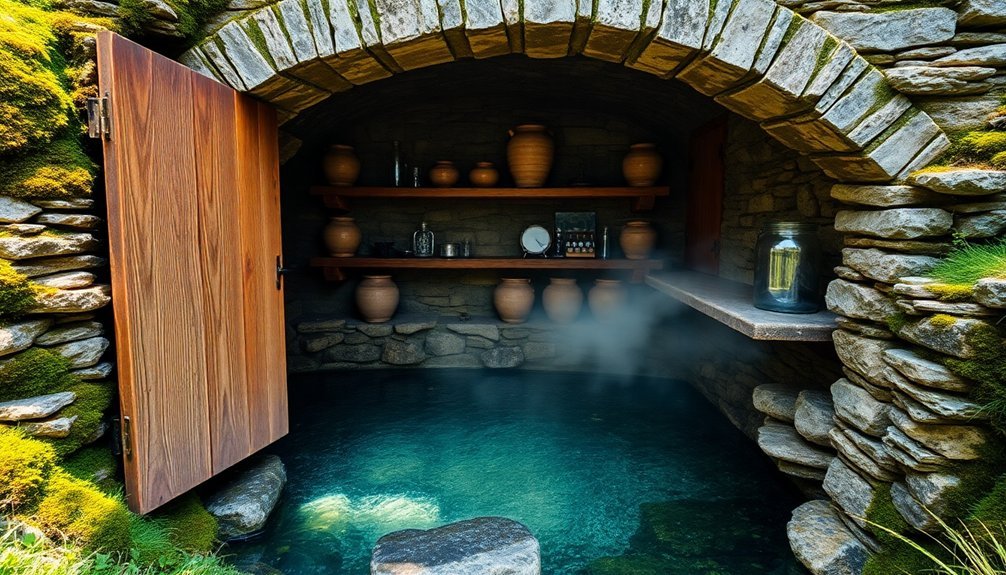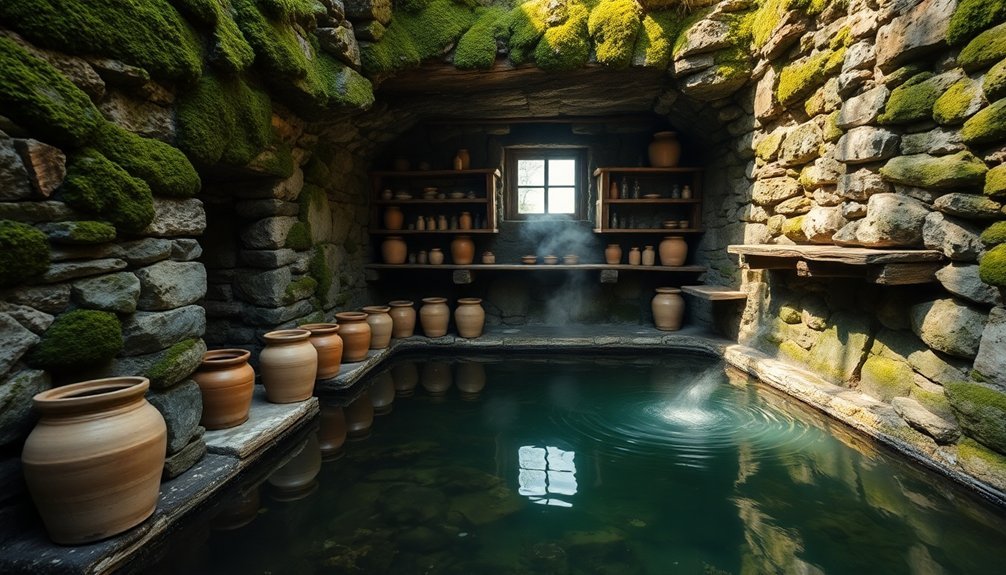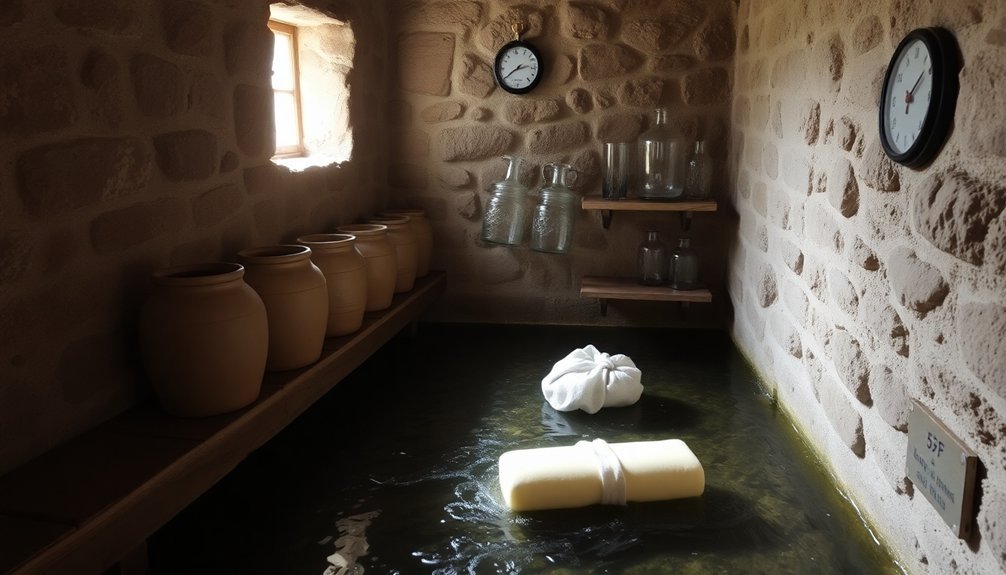Spring houses give you incredibly effective food storage thanks to their ingenious natural cooling system. Built over natural springs and partially underground, they maintain a constant 50°F temperature year-round without using any electricity. You'll find the flowing spring water and high humidity levels (85-95%) create perfect conditions for preserving dairy, meat, fruits, and vegetables for months. The two-room design, with separate spring and storage areas, maximizes cooling efficiency while preventing spoilage. Earth-bermed construction protects your food from external temperature changes, making spring houses a sustainable solution that's stood the test of time. Discovering how these structures revolutionized food preservation reveals even more fascinating benefits.
Natural Cooling System Design

Through careful engineering and natural water utilization, a spring house's cooling system relies on the fundamental principles of flowing spring water and thermal mass.
You'll find the structure built directly over a natural spring, where excavation reaches about four feet deep to maximize cooling efficiency. The design incorporates a concrete foundation with reinforcing bars, creating a stable platform that maintains consistent temperatures. The constant 50°F temperature helps preserve food items throughout the year.
The heart of the cooling system lies in its strategic water channeling. You'll see a carefully constructed trench and trough system that directs spring water through pipes, maintaining a continuous flow that keeps stored food at ideal temperatures.
The concrete blocks create shelving levels, allowing you to place taller containers in deeper water while shorter crocks rest on elevated platforms.
The two-room design enhances the cooling effect by separating the spring room from the refrigeration area. You'll benefit from the cold ambient temperatures maintained by the surrounding earth and flowing water.
The retaining wall prevents contamination while maintaining the integrity of the water flow, ensuring your stored items remain fresh in this naturally refrigerated environment.
Water Temperature Control Benefits
Building upon the natural cooling system, the spring house's water temperature control offers remarkable preservation capabilities.
You'll find that springs maintain a consistent temperature of around 50 degrees Fahrenheit throughout the year, creating an excellent environment for preserving perishable foods, especially dairy products. This steady temperature effectively slows bacterial growth and extends your food's shelf life. Unlike higher temperatures which can promote bacterial growth, the 50-degree water keeps food well below the dangerous 140°F threshold where bacteria multiply rapidly.
You're getting protection from external temperature fluctuations thanks to the spring house's enclosed structure. The building shields your stored items from direct sunlight and heat, while its stone-lined channels and earth-sheltered design maximize cooling efficiency.
The continuous flow of spring water guarantees your food stays uniformly cool.
You can store items either directly in the water channel or on shelves within the cool space. For liquid items like milk, you'll want to place them in crocks within the water flow for best cooling.
What's particularly advantageous is that this system's versatility extends beyond just food storage. You'll be able to use the space for various household tasks, from laundry to dairy work like churning butter, while the fresh spring water serves multiple domestic needs.
Food Preservation Capabilities

Spring houses excel at preserving a diverse range of foods through their natural cooling system. You'll find that the consistent 50°F temperature notably slows down food spoilage, allowing storage periods of several months. The preservation capabilities extend to various food types, from dairy products to large cuts of meat. Maintaining a humidity of 85-95% is crucial for optimal food preservation, similar to traditional root cellars.
You can store milk and other dairy items directly in the water channel using crocks or jugs, maximizing the cooling effect. For meats, you'll want to utilize the hanging space from the rafters, while pickled and corned items work best in stoneware crocks placed on shelves or the floor. Fruits also benefit from the cool, stable environment, maintaining their freshness longer than at room temperature.
What makes this system particularly effective is its year-round reliability. You don't need to worry about seasonal temperature fluctuations affecting your food storage.
The spring house's natural cooling method, combined with proper storage techniques like shelving and hanging, creates an organized and efficient preservation system. The stable humidity levels further enhance the preservation process, making spring houses a remarkably effective solution for long-term food storage without requiring any external power source.
Sustainable Environmental Impact
Your spring house offers a remarkably sustainable food storage solution with its zero energy consumption, as it relies entirely on natural spring water for cooling rather than electricity.
You'll find that this approach to food preservation manages natural resources efficiently, channeling spring water through the structure while maintaining ideal temperatures without depleting additional resources.
The environmental benefits extend far beyond energy savings, as spring houses reduce food waste through effective preservation, minimize water consumption, and maintain a small physical footprint on the landscape.
Zero Energy Consumption
While modern refrigeration systems consume substantial electricity, a spring house operates with remarkable efficiency by requiring absolutely no energy input.
You'll find that this ingenious structure harnesses a natural spring's consistent 50-degree Fahrenheit water temperature to create a sustainable cooling environment, completely eliminating the need for artificial refrigeration.
You can store your perishable items either directly in the spring water or within the cool air space that surrounds it.
The building's design maintains this cold environment naturally, protecting the water source while creating an ideal storage space for dairy products, produce, and other temperature-sensitive foods.
You won't need to worry about energy bills or power outages affecting your food storage, as the spring house functions independently of external power sources.
This zero-energy approach not only saves you money but also eliminates greenhouse gas emissions typically associated with conventional refrigeration.
When you use a spring house, you're participating in a time-tested method of food preservation that supports sustainable living practices while reducing your environmental impact.
The system's ability to maintain consistent temperatures without any energy input makes it an exemplary model of sustainable food storage.
Natural Resource Management
Through careful design and natural integration, a spring house exemplifies sustainable resource management at its finest. You'll find that these structures make excellent use of natural water flow by channeling it along interior walls, creating an efficient cooling system without any mechanical intervention. This smart design means you're conserving water while maintaining ideal storage conditions for your perishable foods.
What's particularly impressive is how spring houses minimize their environmental footprint. You'll notice they're built to blend seamlessly with the surrounding landscape, requiring minimal land area while preventing soil erosion and maintaining ecosystem health. They're constructed using local materials, which greatly reduces transportation-related carbon emissions and resource consumption.
The structure's impact on biodiversity is remarkably low. You're preserving local ecosystems since there's no disruption to natural water flow patterns, and you won't need chemical preservatives for food storage.
The spring house's durability means you'll rarely need repairs or replacements, further reducing resource consumption over time. By utilizing these natural preservation methods, you're supporting sustainable food systems while protecting the surrounding environment for future generations.
Long-Term Environmental Benefits
Long-term environmental benefits of spring houses extend far beyond their primary food storage function.
You'll find these structures considerably reduce energy consumption by utilizing natural spring water for cooling, eliminating the need for electricity-powered refrigeration. This sustainable approach helps decrease greenhouse gas emissions while preserving valuable energy resources for other essential needs.
The durability of spring houses makes them remarkably eco-friendly. You won't need frequent replacements or repairs, as they're built from lasting materials like local fieldstone that can endure for centuries. This longevity minimizes construction waste and resource consumption over time.
- Natural cooling processes prevent food spoilage, reducing waste and the need for disposable packaging materials
- Water management systems protect surrounding ecosystems and maintain biodiversity
- Reusable storage containers like stoneware crocks eliminate single-use packaging waste
You're also contributing to natural resource preservation when using a spring house.
These structures protect crucial water sources through efficient channeling and proper runoff management. The construction methods and materials support local ecosystems while ensuring the spring's long-term health.
Historical Agricultural Importance

You'll find that spring houses revolutionized dairy production by providing a reliable cooling system for milk processing and butter churning, making it possible for farms to expand their dairy operations beyond immediate consumption.
Your ancestors could maintain a steady supply of fresh dairy products throughout the year, transforming local agriculture from subsistence farming to small-scale commercial production.
Spring houses let you achieve a remarkable level of food self-sufficiency, as they enabled the preservation of not just dairy, but also meat, fruits, and vegetables for extended periods.
Dairy Production Revolution
How did a simple milk test transform America's dairy industry? When Professor Stephen M. Babcock developed his groundbreaking butterfat test in 1890, he revolutionized dairy production.
Before this innovation, you'd find that farmers received the same price for their milk regardless of quality, leading to widespread dilution with water and inconsistent products. The Babcock test changed everything by providing a quick, inexpensive way to measure milk's butterfat content right on the farm.
The test's impact rippled through the dairy industry, particularly in Wisconsin, where springhouses were already playing a significant role in milk storage and processing. These cool structures, built over springs or streams, provided the perfect environment for dairy production.
When combined with the new quality testing method, you'll find that dairy farming became more scientific and profitable.
Key transformations included:
- Selective breeding of cows for higher butterfat production
- Standardization of milk pricing based on quality
- Development of more efficient dairy manufacturing processes
Within just one generation, these changes helped Wisconsin emerge as a leading dairy producer, transforming from wheat farming to becoming America's dairy heartland.
The combination of springhouse cooling and quality testing created an unstoppable force in dairy production.
Local Food Self-Sufficiency
When colonial farmers first settled in New England, self-sufficiency wasn't just a choice – it was vital for survival. They developed resilient agricultural practices, growing indigenous crops like corn, beans, and squash while supplementing their diet through hunting and fishing. Over two and a half centuries, they honed their skills in land clearing and soil cultivation.
You'll find that this historical emphasis on food self-sufficiency provided significant protection against natural disasters and transportation disruptions. Local food production helped maintain stability in the food system, while supporting niche markets for specialty products.
| Self-Sufficiency Benefits | Agricultural Methods | Cultural Impact |
|---|---|---|
| Food Security | Indigenous Crop Growing | Community Resilience |
| Crisis Protection | Hunting & Fishing | Independence |
| Market Stability | Dairy & Specialty Crops | Rural Lifestyle |
While complete food self-sufficiency isn't practical in today's world, the principles remain valuable. You'll see its influence in modern farmland preservation efforts and local food systems. This balance between self-sufficiency and trade maintains a connection to our agrarian heritage while supporting environmental standards and community independence.
Year-Round Storage Advantages
What makes spring houses such remarkable food storage solutions? You'll find their year-round effectiveness lies in their ingenious natural cooling system and humidity control. By utilizing flowing spring water and stone-lined channels, these structures maintain a consistent 50°F temperature while providing the perfect moisture levels for food preservation.
You won't need to worry about seasonal changes affecting your stored items, as the spring house's design works efficiently throughout the year. The combination of earth-bermed construction and constant water flow creates an excellent environment that protects your food from both summer heat and winter frost.
When you store dairy products, meats, fruits, and vegetables in a spring house, you're taking advantage of a system that naturally preserves food without requiring external energy sources.
- The multi-level design allows you to organize different food types according to their specific storage needs, maximizing preservation effectiveness.
- You'll benefit from the consistent humidity levels that prevent food from drying out while maintaining ideal texture and flavor.
- Your stored items will last longer thanks to the natural cooling system that works continuously, regardless of outside temperature fluctuations.
Frequently Asked Questions
How Long Does It Take to Construct a Traditional Spring House?
You'll need 3-6 weeks to build a traditional spring house, depending on your skill level, available materials, and weather conditions. The process includes site preparation, stone construction, and finishing interior elements.
Can Spring Houses Be Effective in Areas With Seasonal Water Sources?
You'll find spring houses less effective with seasonal water sources. While they can work during flowing periods, you'll need backup cooling methods like CoolBot technology or alternative storage solutions during dry seasons.
What Maintenance Is Required to Keep a Spring House Functioning Properly?
You'll need to regularly clean surfaces, check ventilation systems, maintain proper water flow, repair structural damage, and sanitize storage areas. Don't forget to monitor humidity levels and clear debris from channels.
Are There Specific Building Materials That Work Better for Spring Houses?
You'll want to use stone and brick for their thermal mass, while incorporating adobe bricks for water resistance. Add cordwood mixtures for extra insulation, and guarantee concrete's used for moisture-resistant foundations and channels.
How Do Modern Health Regulations Affect the Use of Spring Houses?
You'll need to meet strict FDA food safety standards when using a spring house, including regular inspections, proper sanitation protocols, and detailed documentation. Modern regulations require careful monitoring of temperature and storage conditions.
In Summary
You'll find that spring houses remain remarkably effective for food storage thanks to their ingenious use of natural cooling principles and consistent water temperatures. They've stood the test of time, offering you a sustainable way to preserve food without electricity. Whether you're storing dairy products, fruits, or vegetables, you can rely on this time-tested method that's kept foods fresh for generations of farmers and homesteaders.





Leave a Reply